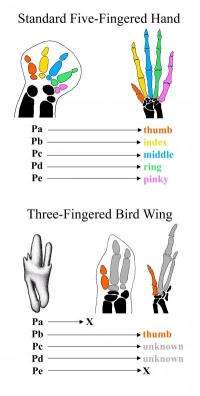Researchers solve mystery of disappearing bird digit

Evolution adds and subtracts, and nowhere is this math more evident than in vertebrates, which are programmed to have five digits on each limb. But many species do not. Snakes, of course, have no digits, and birds have three.
Yale scientists now have a good handle on how these developmental changes are orchestrated in the embryo, but there is still one outstanding debate on birds: Which digits are they: a thumb with index and middle fingers, or the index, middle and ring fingers?
In five-digit vertebrates, the thumb comes from the precursor stem cells labeled pa. While birds have a digit that looks like a thumb, pa precursor cells die off during development and never produce a digit in adults. As a result, scientists have wondered whether precursor cells in pb can make a thumb.
Yale scientists have completed a genomic analysis of birds that reveals the answer (shown in orange on illustration). It is a hands down "yes" — even though the first bird digit develops where the index finger on a five-finger vertebrae should be.
The results are published online Sept. 4 in the journal Nature.
Provided by Yale University
















